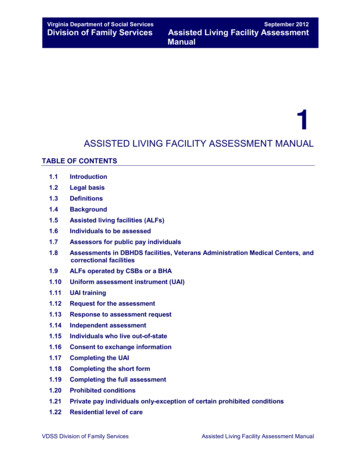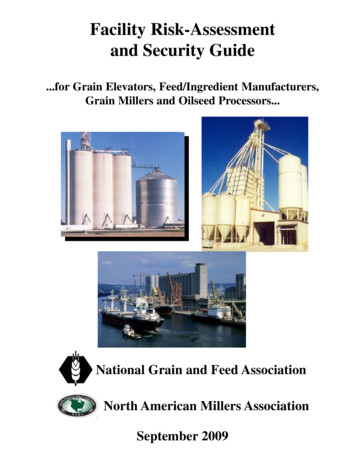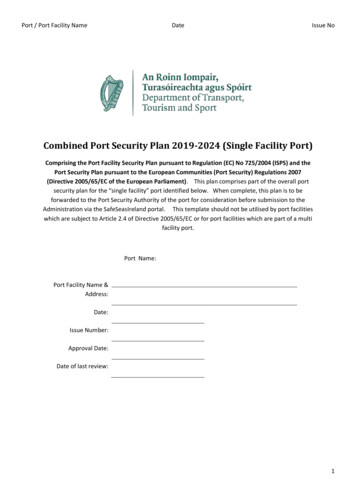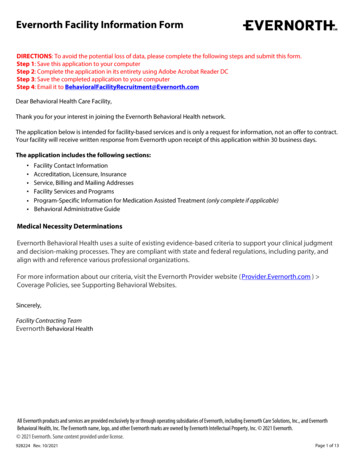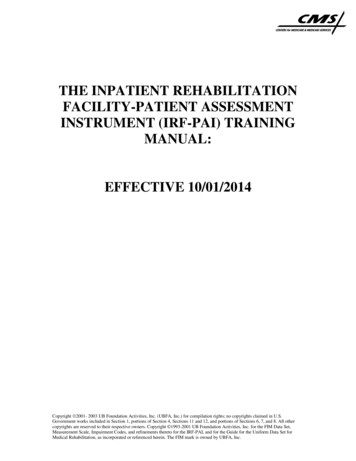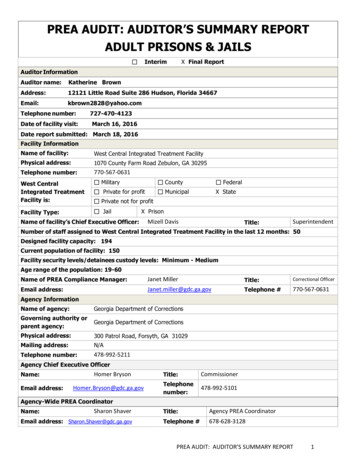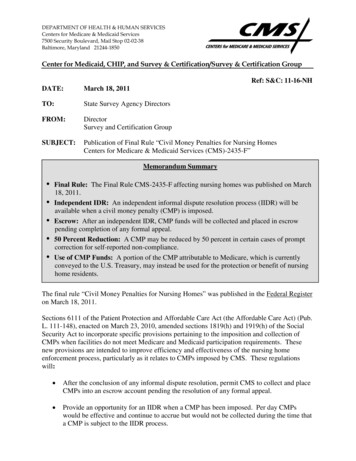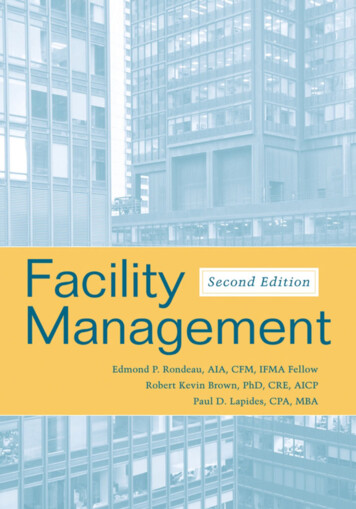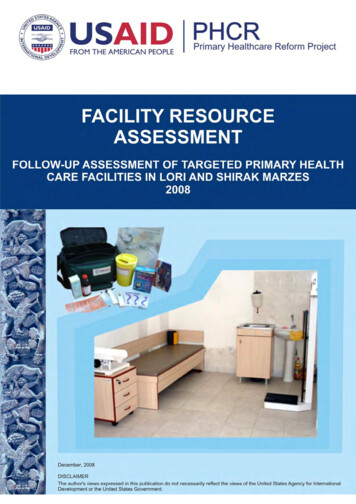
Transcription
FACILITY RESOURCE ASSESSMENTSURVEYFOLLOW-UP ASSESSMENT OF TARGETED PRIMARY HEALTHCARE FACILITIES IN LORI AND SHIRAK MARZES2008DISCLAIMERThis publication is made possible by the support of the United States Agency for InternationalDevelopment (USAID). It was prepared by the Primary Health Care Reform (PHCR) Project, Armenia. Theauthor’s views expressed in this publication do not necessarily reflect the views of the USAID or theUnited States Government.
PrefaceThe Primary Healthcare Reform (PHCR) project is a nationwide five-year (2005-2010)program funded by the United States Agency for International Development (USAID) undera contract awarded to Emerging Markets Group, Ltd. (EMG) in September 2005. ThePHCR’s primary objective is the increased utilization of sustainable, high-quality primaryhealthcare services leading to the improved health of Armenian families. This objective isoperationalized by supporting the Ministry of Health (MoH) to implement a package of sixinterventions that links policy reform with service delivery so that each informs the othergenerating synergistic effects. These six interventions address healthcare reforms and policysupport (including renovation and equipping of facilities); open enrollment; family medicine;quality of care; healthcare finance; and public education, health promotion and diseaseprevention.“What impact are these interventions having?” is a question frequently asked but lessfrequently funded. Fortunately, provision was made in the PHCR project to address the“impact” question. PHCR developed a set of six tools to monitor progress and evaluateresults. Three of these tools are facility-based and are designed to assess changes through apre-test and post-test methodology at 164 primary healthcare facilities and their referralfacilities. Three other tools are population-based and are designed to assess changes for thewhole of Armenia’s population, using the same pre-test and post-test methodology.This report summarizes the follow-up facility resource assessment of targeted primaryhealthcare facilities in Lori and Shirak marzes (Zone 1). This follow-up assessment evaluatesthe project impact in Zone 1 through comparisons of selected facility-level physical andhuman resource indicators against the baseline dataset from 2006.The Center for Health Services Research and Development of the American University ofArmenia, one of the sub-contractors to EMG, has primary responsibility for PHCRmonitoring and evaluation. Dr. Anahit Demirchyan, Ms. Tsovinar Harutyunyan, Dr. VarduhiPetrosyan, and Dr. Michael Thompson are the primary authors of this study. We would alsolike to thank Dr. Hripsime Martirosyan and Ms. Nune Truzyan for their valuable contributionto all stages of the study. We would also like to thank our interviewers (primary healthcarephysicians in the target marzes) for their data collection efforts.We trust that the findings of this study will be of value, both in improving health outcomesthrough more informed decision-making and in designing new projects. The report can befound on the PHCR website at www.phcr.am. Comments or questions on this study arewelcome and should be sent to info@phcr.am.Richard A. Yoder, PhD, MPHChief of PartyPrimary Healthcare Reform Projectii
Table of contentsPreface. iiList of Acronyms . iv1. Introduction.12. Methods.23. Results .43.1Structure, resources, personnel .43.2Family medicine.63.3Open enrollment, financing, and management .103.4Public education.153.5Main findings .18Appendix 1. PHCR, Resource assessment tool for PHC facilities.21Appendix 2. Lists of furniture & equipment provided to targeted facilities.35Appendix 3. Per-facility summary scores for physical conditions, equipment &furniture.36iii
List of FUSAIDWBWHOWVYSMUAmerican University of ArmeniaAcquired Immune Deficiency SyndromeAmerican International Health AllianceArmenian Red Cross SocietyAcute Respiratory IllnessesArmenian Social Transition ProgramBasic Benefits PackageBasic Medical CollegeCommunity Health CommitteeCoronary Heart DiseaseAUA Center for Health Services Research and DevelopmentDrug and Medical Technology AgencyDirectly Observed Treatment Short CourseEvidence-Based MedicineEmerging Markets GroupRural Health Post (from Russian abbreviation)Family MedicineFamily NursingGeneral PracticeHealth CenterHuman Immunodeficiency VirusInternational Child’s Care OrganizationThe Institute of International Cooperation of the Consortium of German PeoplesIntegrated Management of Childhood IllnessesInternational Relief and DevelopmentJinishian Memorial FoundationMedical AmbulatoryMonitoring and EvaluationMinistry of HealthMedicines sans FrontiersNational Institute of HealthStrengthening Reproductive and Child Health Care Services in Rural Areas(from Armenian abbreviation)Open Society InstitutePolyclinicPrimary Health CarePrimary Health Care ReformPerformance Monitoring PlanRepublic of ArmeniaState Health AdministrationSexually Transmitted DiseasesRural Medical Ambulatory (from Russian abbreviation)United Methodist Committee of ReliefUnited NationsUnited Nations Children’s FundUnited States Agency for International DevelopmentWorld BankWorld Health OrganizationWorld VisionYerevan State Medical Universityiv
Follow-up Resource Assessment of Targeted Primary Health Care Facilities in Lori and Shirak Marzes1. Introduction1.1 PHCR Project Overview: The United States Agency for International Development(USAID) awarded Emerging Markets Group (EMG), an international consulting firm, a five-yearcontract to run the Primary Health Care Reform (PHCR) Project in Armenia. The primary goal ofthe Project is to improve population access to quality primary healthcare services throughstrengthening Primary Health Care (PHC) facilities and family medicine providers, on one hand,and improving public health awareness, health-seeking behavior, and competent demand for PHCservices, on the other. The six main components of PHCR project are run in partnership withIntraHealth International Inc., American University of Armenia, Overseas Strategic Consulting,Ltd., and Social Sectors Development Strategies, and include the following activities:o Expansion of Reforms: assisting the Government in establishing a supportive regulatoryoooooenvironment for the advancement of reforms; renovating and equipping PHC facilitiesnationwide; designing and delivering training to facility managementFamily Medicine: developing up-to-date curricula and training materials for continuousmedical education; creating free-standing family medicine group practices; providing trainingto family physicians and nursesOpen Enrollment: introducing the open enrollment principle in the Armenian healthcaresector to promote customer-oriented services by fostering competition among providersQuality of Care: improving the quality of care by introducing state-of-the-art qualitystandards and quality assurance proceduresHealthcare Finance: increasing the transparency and efficiency of the distribution ofhealthcare funds through improved service costing and performance-based contractingpractices; enhancing accountability at the facility level; determining the use of NationalHealth AccountsPublic Education: enhancing awareness about PHC services offered; improvingunderstanding of open enrollment and acceptance of family medicine providers; promotinghealthy lifestyle and health-seeking behavior.The project utilizes a regional scale-up approach, which allows for the zonal expansion of thereforms throughout the country over the life of the project. While applying this approach, theproject primarily focuses on upgrading physical conditions and enhancing delivery of care inselected facilities in each zone, overall targeting approximately three hundred facilities throughoutArmenia. The project targeted Shirak and Lori marzes for the first two years (2006-2008) of itsimplementation.The project conducted several activities in its target facilities, including renovation, furnishing, andprovision of equipment, as well as training of medical and administrative staff in family medicine,quality of care, management, financing/accounting, implementation of software for accounting andopen enrollment. Selected communities served by the targeted facilities also became targets,particularly, for the public education component of the PHCR project in terms of getting involvedin establishing and running Community Health Committees, utilizing small grant projects.However, not all selected facilities were targeted for all types of activities: different sets ofactivities were implemented in different facilities, based on local needs and priorities.1.2 PHCR Project Monitoring & Evaluation Plan: The following assessments are beingconducted throughout the project to monitor its implementation and evaluate its impact:1) Baseline assessments, including:1
Follow-up Resource Assessment of Targeted Primary Health Care Facilities in Lori and Shirak Marzes Facility level assessments in target facilities at the start of the project activities in eachmarz. These include: 1) Facility resource assessment covering structural indicators for allproject components, with some of them being Performance Management Plan (PMP)indicators;2) Facility performance assessment covering performance of facility andproviders which could serve as a basis for measuring improvement in quality of care;Population-based assessments. These include: 1) Client satisfaction survey; 2) KAP surveycovering the health information topics provided to selected communities by the PHCRproject through Community Health Committees (CHC); 3) Countrywide household healthsurvey covering main health outcome measures of the population including perceived healthstatus, health dynamics, use of early diagnostics and preventive services, accessibility andperceived quality of care, and exposure to/attitude towards activities implemented by thePHCR project.2) Intermediate and final assessments, including: Repeating the facility level assessments mentioned above upon completion of the projectactivities in target facilities of each marz. Repeating the population-based assessments upon completion of the project activities intarget marzes (for client satisfaction and KAP surveys) and countrywide (for the householdhealth survey) covering all the areas mentioned in the baseline surveys.This report summarizes the data on follow-up facility resource assessment conducted in facilitiestargeted by the PHCR project in Lori and Shirak marzes. This assessment evaluates the project’simpact on targeted PHC facilities in the first zone.2. MethodsThe PHCR Project staff and corresponding marz health department staff jointly selected targetfacilities in Zone 1 (Lori and Shirak marzes), where the project activities were implemented from2006 through 2008. PHCR implemented the following activities in the targeted facilities and theircommunities:1)2)3)4)Renovation of PHC facilitiesProvision of basic furniture, medical equipment and suppliesTraining of rural nurses in family and community nursingEstablishment of Community Health Committees (CHCs) in rural communities to providepreventive and promotional health education to the members of communities5) Distribution of health education materials (including TV and radio announcements, posters,and leaflets, to boost awareness of PHC reforms and services and selected health issues6) Training of facility managers (referral facilities) in PHC reforms, strategic planning,financial management, human resource management, labor legislation, and quality of carebasics7) Training of facility chief accountants and accountants in accounting standards, costaccounting, tax legislation, as well as in use of computerized accounting software.During 2006-2008, the PHCR Project also implemented several nationwide activities. Theseactivities addressed efforts to shift to an open enrollment-based PHC model and to strengthen thefinancing of the facilities through performance-based payment and enrollment-based financing.Activities included providing requisite hardware and software to all higher-level PHC facilities(medical ambulatories (MAs), health centers (HCs), and polyclinics (PCs)) and trainings of therelevant staff (e.g., operators, and accountants).2
Follow-up Resource Assessment of Targeted Primary Health Care Facilities in Lori and Shirak MarzesThe PHCR Monitoring and Evaluation (M&E) team conducted two types of assessments in theselected facilities: facility resource assessment and facility/provider performance assessment.Facility resource assessment instrument. Unlike the baseline assessment in Zone 1, a singleinstrument was used to conduct the resource assessment of all types of facilities (FAPs,ambulatories, health centers, and polyclinics) at follow-up. This instrument combined all specificfeatures of the initial two instruments (for FAPs/ambulatories and for health centers/polyclinics)used in Zone 1 (Appendix 1).The facility resource assessment instrument addressed the following domains: Facility status & resources, including staff, rooms, renovation status, water supply &sewage system, electricity & heating, equipment & furniture Status in PHCR project focal areas, including resources and potential for family medicine,quality of care, open enrollment, financing/management, and public education; and Select health indicators of the population served.Sample. A total of 61 PHC facilities were-assessed during May 2008 (30 facilities in Lori marzand 31 facilities in Shirak marz). Three sites were dropped following the baseline: two (ShirakFAP and Jrapi FAP) had been excluded from the project target sites and one (Stepanavan PC) wasexcluded, as it was no longer considered the referral site for the targeted FAP (Urasar). Table 1presents the list of target and referral facilities in Lori and Shirak marzes included in thisassessment.Table 1. PHCR project target facilities in Shirak and 9.20.21.†FAPs selected forrenovation in henBandivanFAPs selected for Network centers forrenovation sites inrenovation inLori marzLori marz1. Shamut22. Dsegh HC2. Lorut†3. Dzoragyugh23. Vahagni HC4. Fioletovo24. Maragahovit HC5. Lermontovo†6. GhursalSpitak polyclinic*7. Lernantsk8. Haghpat†25. Alaverdi polyclinic9. Jiliza†10. Khnkoyan26. Mets Parni HC11. Lusaghbyur†12. Sarahart†13. Lernahovit27. Tashir polyclinic14. Medovka15. Novoseltsevo16. Saramedj†28. Jrashen amb.†17. Teghut29. Shnogh amb.18. Urasar30. Katnaghbyur amb.PCs/MAs selected for renovation in Lori marz19. Spitak Polyclinic20. Tumanyan amb.21. Lernapat amb.Network centers forrenovation sites inShirak marz22. Panik HC23. Jajur amb.24. Marmashen amb.25. Horom amb.26. Akhuryan polyclin.27. Mayisyan amb.28. Akhurik amb.29. Anipemza HC30. Aghin HC31. Amasia HCCommunity Health Committee was established* Selected also as a renovation site3
Follow-up Resource Assessment of Targeted Primary Health Care Facilities in Lori and Shirak MarzesLogistics. During a two-day workshop, the M&E team trained interviewers to consistently andeffectively implement the facility resource assessment and facility/provider performanceassessment survey protocols. Three interviewers in Lori marz and three interviewers in Shirak (alllocal physicians, five of whom had also implemented the baseline assessment) were (re)trained.Locally hired drivers took the interviewers to the selected facilities. The fieldwork lastedapproximately five weeks (started on April 29 and finished in the last week of May 2008). TheM&E team conducted periodic spot-checks of the interview process to assure compliance with thesurvey protocol.Analysis. The data entry team of AUA Center for Health Services Research and Development(CHSR) coded responses into computer databases using SPSS 11.0 software. The M&E team usedthe paired sample t-test (continuous data) and the Wilcoxon Signed Ranks Test (proportions) toevaluate pre-post comparisons.3. ResultsThe PHCR Project had renovated 18 FAPs, 2 ambulatories and one polyclinic in Lori marz and 21FAPs in Shirak marz. Renovated FAPs were also provided furniture and medical equipment (seeAppendix 2) and public educational materials (covering the topics on family medicine, openenrollment, and BBP, healthy bones, diabetes, hypertension, child care and nutrition, urinary tractinfections, tuberculosis, prevention of sexually transmitted diseases, and reproductive health). Inaddition, one nurse per FAP was trained in Family and Community Nursing (a 6.5-monthcertification course). In select communities, Community Health Committees were established (seeTable 1).PHCR Project interventions in referral-level PHC facilities included staff training on financing,management, and clinical topics, introduction of computerized accounting and open enrollmentsystems, and provision of medical equipment.This chapter presents the results of the 2008 follow-up facility resources assessment (includingboth material and human resources) as compared to the 2006 baseline assessment that wasconducted prior to the PHCR Project launch.3.1 Structure, resources, personnelStaff: At follow-up, the mean number of employees was 1.2 for FAPs, 10.0 for MAs, 17.4 forHCs, and 77.3 for PCs. While the staffing levels were not significantly different from that atbaseline, MAs showed an increase in total mean number of employees (from 8.5 to 10.0) whileHCs - a decline (from 20.9 to 17.4). The mean number of nurses and doctors providing PHCservices in the assessed facilities also remained unchanged. Significant changes occurred in thenumber of family nurses employed in FAPs (absolute numbers: from 0 to 40, mean number: from 0to 1.0, p 0.000) and in the number of family physicians employed in the referral level PHCfacilities (absolute numbers: from 19 to 38, mean number: from 0.9 to 1.7, p 0.000) (Table 2).4
Follow-up Resource Assessment of Targeted Primary Health Care Facilities in Lori and Shirak MarzesTable 2. Total number of PHC providers in the assessed facilities by training/specializationFamilyphysicians*GPs 7*p .000Physical Conditions. Based on the following criteria the M&E team constructed a cumulativescore reflecting the physical condition of the facilities: examination/procedure room size, lighting,and renovation status. For room size, a full score of 1 was assigned if the room was at least 4*3meters, its renovation status was subjectively assessed as satisfactory, and lighting was deemedappropriate (e.g., the room had window(s) with a glass surface not less than a tenth of the room’sarea) in at least one room in a FAP or at least one room per PHC doctor in a higher-level facility. Ifthe criteria had been partially met and the renovation status was satisfactory, a half score wasassigned. A zero was assigned if the facility needed renovation.For all the assessed facilities, the mean cumulative score for physical conditions was 0.24 atbaseline and 0.86 at follow-up (p 0.000). This increase was particularly evident for FAPs (from0.13 to 0.96). For MAs, the increase in physical condition score was more modest, but stillsignificant (from 0.35 to 0.75, p 0.022). A slight (insignificant) increase was observed for HCs(from 0.50 to 0.75) and a slight (insignificant) decrease was observed for PCs (from 0.50 to 0.38).Appendix 3 provides the per-facility summary of renovation scores.Water supply/sewage system. At baseline, 68.9% of the assessed facilities (of which, 92.3% ofFAPs and 40.0% of MAs) had no piped water supply. This proportion decreased somewhat atfollow-up: no piped water supply was documented in 59.0% of the facilities (of which, 82.1% ofFAPs and 20.0% of MAs). However, this difference only approached statistical significance(p 0.058). The mean daily duration of water supply was 5.3 hours in 2006 and 8.0 hours in 2008(p 0.021) among all facilities. In facilities with piped water supply, the mean daily duration of thewater supply was 17.0 hours (range: 1.0-24.0) at baseline and 19.6 hours (range: 3.0-24.0) atfollow-up. Among the 39 FAPs, only 4 (10.5%) reported having a sink with running water in 2006and 14 (35.9%) in 2008. The observed increase was significant (p 0.013). After the baseline, 4FAPs constructed sewage systems increasing the proportion of FAPs with a sewage system from12.8% to 23.1%. Due to this, among all facilities, the proportion of those with sewage systemincreased from 36.1% to 42.6%.Of the 39 FAPs, none had a functioning toilet or shower facility at baseline and only one had afunctioning pit latrine. The situation had only marginally improved at follow-up with two FAPshaving functioning toilets and two functioning pit latrines.Of the 22 higher-level facilities, three (Horom MA, Anipemza HC, and Aghin HC in Shirak marz)had no functioning toilet, pit latrine, or shower at baseline. At follow-up, one of these three (AginHC) obtained functioning toilets, but another higher-level facility (Katnaghbyur in Lori marz)joined the first two in terms of being lacking of these commodities. The mean number offunctioning toilets/pit latrines per facility was 2.8 in 2006 and 3.1 in 2008. Five facilities hadfunctioning showers at baseline and at follow-up; however, the mean number of functioning showerstations decreased from 0.73 to 0.45.5
Follow-up Resource Assessment of Targeted Primary Health Care Facilities in Lori and Shirak MarzesElectricity, heating. Twenty-four hour electricity was available to 28 FAPs (73.7%) in 2006. Thisrate increased in 2008 to 36 FAPs (92.3%). The difference was statistically significant (p 0.035).However, three FAPs (Bandivan and Gtashen in Shirak and Lernancq in Lori) and one MA(Katnaghbyur in Lori marz) reported no electricity supply at follow-up.At baseline, 12 facilities (11 FAPs and one MA) reported having no heating during winter. Atfollow-up, this number decreased to four (Bandivan and Gtashen FAPs in Shirak and Lernancq andShamut FAPs in Lori). This difference was significant (p 0.007). The mean number of roomsheated during winter was 1.9 in 2006 and 4.4 in 2008 (p 0.002). This pattern was true for allfacility types: from 0.7 to 1.1 for FAPs, from 3.4 to 4.6 for MAs, from 2.1 to 6.3 for HCs, and from8.3 to 30.8 for PCs. Portable electric heaters were used primarily at follow-up, reflecting adecrease in usage of room heaters with flue.Furniture & equipment. Summative furnishing and equipment scores were calculated for eachfacility to assist in making baseline/follow-up comparisons. The M&E team constructed variablesto reflect the total number of functional units of each of 12 types of furniture and 70 types ofequipment in each facility on a per-provider basis (per-nurse for FAPs and per-PHC doctor forhigher-level facilities). This per-provider number, by equipment/furniture type, was then comparedto an established norm (developed with PHCR Project’s Family Medicine team). A score of “1”was assigned if the normative quantity for the given type was met and a “0” if unmet. These valueswere then summed and converted to a percentage score (out of 12 for furniture and out of 70 forequipment).Appendix 3 provides per-facility summaries of equipment and furniture scores. The mean furniturescore was 35.9% at baseline and 64.8% at follow-up (p 0.000). The mean equipment score was37.0% at baseline and 45.3% at follow-up (p 0.000). Comparisons by facility-type showed thatfurnishing and equipment status had improved considerably in FAPs and MAs, while noimprovement was observed in higher-level facilities (Table 3). Note that HCs and MAs had thehighest scores at baseline, while FAPs and polyclinics the lowest. At follow-up, the situation atFAPs had improved significantly, while at polyclinics had declined.Table 3. Cumulative mean furniture and equipment scores per facility type, 2006 vs. 2008Furniture scores (%)Equipment scores (%)Type of facility2006200820062008FAPs (n 39)23.365.6*26.940.0*MAs (n 10)62.580.063.976.6**HCs (n 8)62.564.662.162.9PCs (n 4)39.618.618.213.6All facilities35.964.8**37.045.3**(n 61)*The observed difference is significant, p .001**The observed difference is significant, p 0.053.2 Family medicineClinical trainings. In 2006, 31.3% (27) of all PHC physicians (n 86) employed in the assessed 61facilities had been educated at the National Institute of Health (NIH) or Yerevan State MedicalUniversity (YSMU) within the last 5 years; 32.6% (28) expressed willingness to receive FamilyMedicine (FM) education or were in the process of receiving it. In 2008, 83.9% (73) of all PHCphysicians employed in the assessed facilities had completed FM training at NIH / YSMU. Atbaseline, 34.2% (54) of nurses (n 158) in the assessed facilities had been educated in Family6
Follow-up Resource Assessment of Targeted Primary Health Care Facilities in Lori and Shirak MarzesNursing (FN) at NIH or the Basic Medical College (BMC) within the last 5 years; 41.1% (65) werewilling or were in the process of receiving it. In 2008, 64.1% (100) of these nurses (n 156) hadbeen educated in FN at NIH / BMC.The clinical staff members also were asked if they had received short-term clinical trainings on anyof the following topics: first aid, immunization, breastfeeding, sexually transmitted diseases(STDs), reproductive health, integrated management of childhood diseases (IMCI), tuberculosis,healthy lifestyle, and child growth and development within the last 5 years. These topics wereselected because they addressed prevalent conditions in PHC and had been the subject of numeroustraining programs. Information also was gathered about training on topics specifically addressedby the PHCR Project: treatment of chronic conditions (e.g., CHD, diabetes, chronic pain) andprevention of infections. Table 4 shows the distribution of trainings attended by provider type andtopic.Table 4. PHC nurses and doctors recent short-term trainings by topic, 2006 and 2008Topics1.First aid2.Immunization3.Breastfeeding4.Sexually TransmittedDiseases5.Reproductive Health6.IMCI7.Tuberculosis8.Healthy lifestyle9.Healthy child growth &development10.Treatment of chronicconditions (CHD, diabetes)11.Prevention of infectionsTotal number of trainingsMean % having completedany trainingNursesPhysicians2006 (n 158)2008 (n 156)2006 (n 86)2008 (n .05.8331925537.921.822.025.616.026.8Table 4a. FAP nurses short-term trainings by topic, 2006 and 2008FAP NursesTopics1.First aid2.Immunization3.Breastfeeding4.Sexually Transmitted Diseases5.Reproductive Health6.IMCI7.Tuberculosis8.Healthy lifestyle9.Healthy child growth & development10.Treatment of chronic conditions (CHD,diabetes)2006 (n 334.061.70.02008 (n .437.047.821.7
Follow-up Resource Assessment of Targeted Primary Health Care Facilities in Lori and Shirak MarzesFAP NursesTopics11.Prevention of infectionsTotal number of trainingsMean % having completed any training2006 (n 47)n1196%2.137.92008 (n 46)n8231%17.445.7As shown in Table 4, the proportion having received training on IMCI, treatment of chronicconditions, healthy child’s growth and development, and prevention of infections had increasedconsiderably. The mean proportion of PHC nurses having completed training on any of thesetopics in the past 5 years was 22.0% at baseline and 25.6% at follow-up. FAP nurses, as a group,had higher coverage: 37.9% at baseline and 45.7% at follow-up (Table 4a). PHC doctors showedmore improvement, increasing from 16.0% at baseline to 26.8% at follow-up.At follow-up, the participants mentioned the following organizations as providers of trainings:Armenian Red Cross Society, USAID, and NIH for first aid; UNICEF for immunization; UNICEF,Prime, and NOVA/USAID for breastfeeding; NOVA/USAID and Prime for reproductive health;MSF, NOVA/USAID, and Prime for STDs; UNICEF and NOVA/USAID for IMCI; USAID andUNICEF for tuberculosis; PHCR/USAID for healthy lifestyle; UNICEF and NOVA/USAID forhealthy child growth and development; and P
This report summarizes the follow-up facility resource assessment of targeted primary healthcare facilities in Lori and Shirak marzes (Zone 1). This follow-up assessment evaluates the project impact in Zone 1 through comparisons of selected facility-level physical and human resource indicators against the baseline dataset from 2006.
